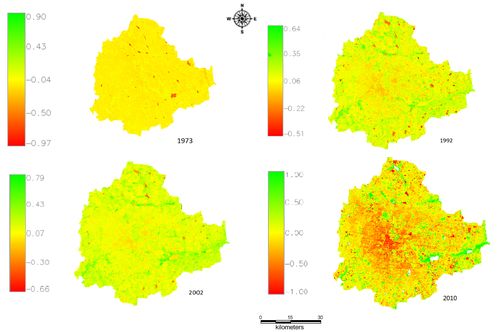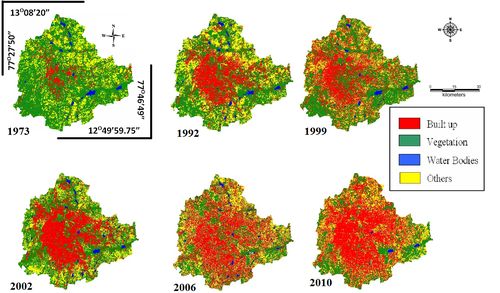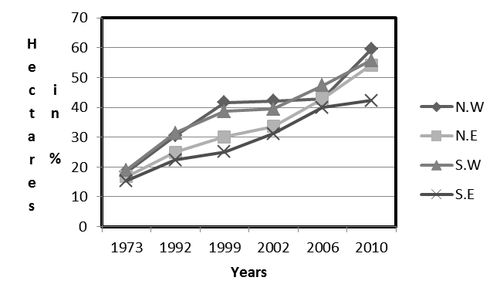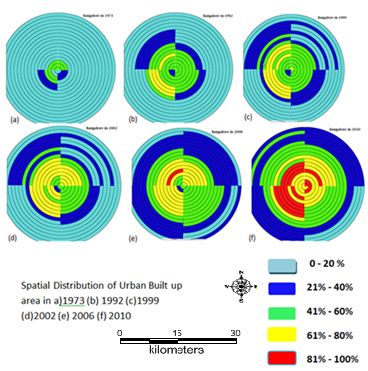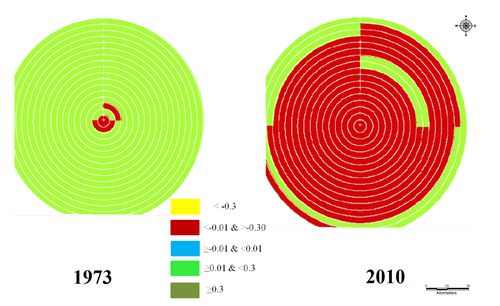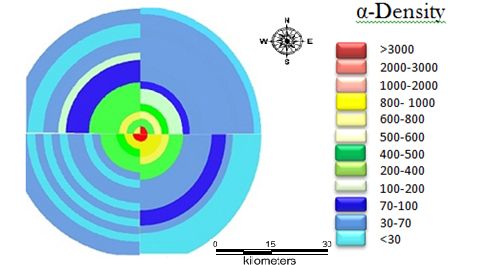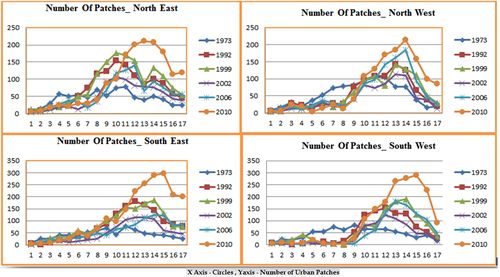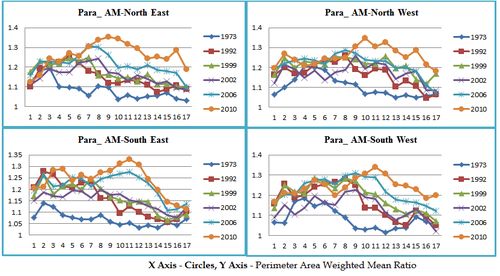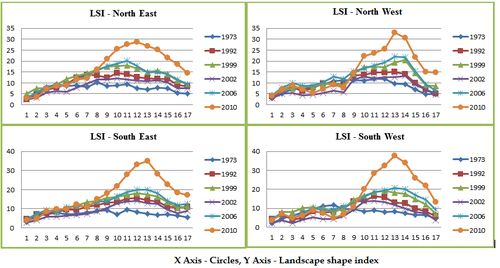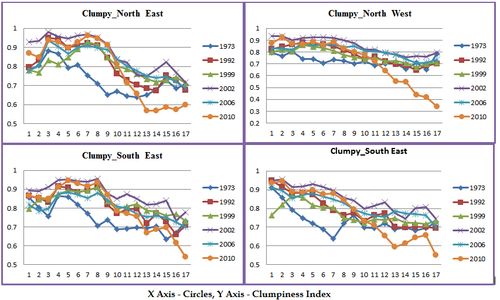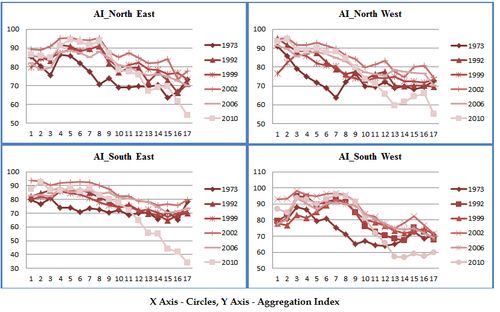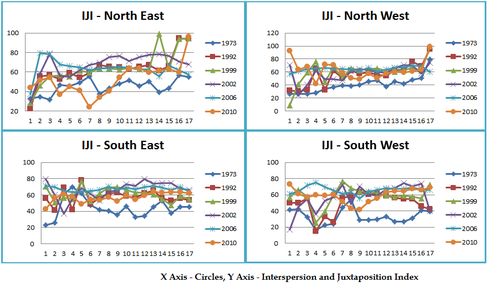|
CASE STUDY: GREATER BANGALORE
Ramachandra, T.V.; Bharath H. Aithal and Durgappa D. S. 2012.
Insights to urban dynamics through landscape spatial pattern
analysis, Int. J Applied Earth Observation and Geoinformation, 18;
329-343, http://dx.doi.org/10.1016/j.jag.2012.03.005.
Insights to Urban Dynamics through Landscape Spatial Pattern Analysis Urbanisation is a dynamic complex phenomenon involving large scale changes in the land
uses at local levels. Analyses of changes in land uses in urban environments provide a
historical perspective of land use and give an opportunity to assess the spatial patterns,
correlation, trends, rate and impacts of the change, which would help in better regional
planning and good governance of the region. Main objective of this research is to quantify the
urban dynamics using temporal remote sensing data with the help of well-established
landscape metrics. Bangalore being one of the rapidly urbanizing landscapes in India has
been chosen for this investigation. Complex process of urban sprawl was modelled using
spatio temporal analysis. Land use analyses show 584% growth in built-up area during the
last four decades with the decline of vegetation by 66% and water bodies by 74%. Analyses
of the temporal data reveals an increase in urban built up area of 342.83% (during 1973 to
1992), 129.56% (during 1992 to 1999), 106.7% (1999 to 2002), 114.51% (2002 to 2006) and
126.19% from 2006 to 2010. The Study area was divided into four zones and each zone is
further divided into 17 concentric circles of 1 km incrementing radius to understand the
patterns and extent of the urbansiation at local levels. The urban density gradient illustrates
radial pattern of urbanization for the period 1973 to 2010. Bangalore grew radially from 1973
to 2010 indicating that the urbanization is intensifying from the central core and has reached
the periphery of the Greater Bangalore. Shannon’s entropy, alpha and beta population
densities were computed to understand the level of urbanization at local levels. Shannon's
entropy values of recent time confirms dispersed haphazard urban growth in the city,
particularly in the outskirts of the city. This also illustrates the extent of influence of drivers
of urbanization in various directions. Landscape metrics provided in depth knowledge about
the sprawl. Principal component analysis helped in prioritizing the metrics for detailed
analyses. The results clearly indicates that whole landscape is aggregating to a large patch in
2010 as compared to earlier years which was dominated by several small patches. The large
scale conversion of small patches to large single patch can be seen from 2006 to 2010. In the
year 2010 patches are maximally aggregated indicating that the city is becoming more
compact and more urbanised in recent years. Bangalore was the most sought after destination
for its climatic condition and the availability of various facilities (land availability, economy,
political factors)compared to other cities. The growth into a single urban patch can be attributed to rapid urbanisation coupled with the industrialisation. Monitoring of growth
through landscape metrics helps to maintain and manage the natural resources. I. Introduction Urbanization and Urban Sprawl: Urbanisation is a dynamic process involving changes in vast
expanse of land cover with the progressive concentration of human population. The process
entails switch from spread out pattern of human settlements to compact growth in urban
centres. Rapidly urbanising landscapes attains inordinately large population size leading to
gradual collapse in the urban services evident from the basic problems in housing, slum, lack
of treated water supply, inadequate infrastructure, higher pollution levels, poor quality of life,
etc. Urbanisation is a product of demographic explosion and poverty induced rural-urban
migration. Globalisation, liberalization, privatization are the agents fuelling urbanization in
most parts of India. However, unplanned urbanization coupled with the lack of holistic
approaches, is leading to lack of infrastructure and basic amenities. Hence proper urban
planning with operational, developmental and restorative strategies is required to ensure the
sustainable management of natural resources. Urban dynamics involving large scale changes in the land use depend on (i) nature of land
use and (ii) the level of spatial accumulation. Nature of land use depends on the activities that
are taking place in the region while the level of spatial accumulation depends on the intensity
and concentration. Central areas have a high level of spatial accumulation of urban land use
(as in the CBD: Central Business District), while peripheral areas have lower levels of
accumulation. Most economic, social or cultural activities imply a multitude of functions,
such as production, consumption and distribution. These functions take place at specific
locations depending on the nature of activities – industries, institutions, etc. Unplanned growth would involve radical land use conversion of forests, surface water bodies, etc. with the irretrievable loss of ground prospects (Pathan et al., 1989, 1991, 1993, 2004). The process of urbanization could be either in the form of townships or unplanned or organic. Many organic towns in India are now influencing large scale infrastructure development, etc. due to the impetus from the National government through development schemes such as JNNURM (Jawaharlal Nehru National Urban Renewal Mission), etc. The focus is on the fast track development through an efficient infrastructure and delivery mechanisms, community participation, etc. The urban population in India is growing at about 2.3% per annum with the global urban
population increasing from 13% (220 million in 1900) to 49% (3.2 billion, in 2005) and is
projected to escalate to 60% (4.9 billion) by 2030 (Ramachandra and Kumar, 2008;
World Urbanization Prospects, 2005). The increase in urban population in response to the growth in urban areas is mainly due to migration. There are 48 urban
agglomerations/cities having a population of more than one million in India (in 2011). Urbanisation often leads to the dispersed haphazard development in the outskirts, which is often referred as sprawl. Thus urban sprawl is a consequence of social and economic development of a certain region under certain circumstances. This phenomenon is also defined as an uncontrolled, scattered suburban development that depletes local resources due to large scale land use changes involving the conversion of open spaces (water bodies, parks, etc.) while increasing carbon footprint through the spurt in anthropogenic activities and congestion in the city (Peiser, 2001, Ramachandra and Kumar, 2009). Urban sprawl increasingly has become a major issue facing many metropolitan areas. Due to lack of visualization of sprawl a priori, these regions are devoid of any infrastructure and basic amenities (like supply of treated water, electricity, sanitation facilities). Also these regions are normally left out in all government surveys (even in national population census), as this cannot be grouped under either urban or rural area. Understanding this kind of growth is very crucial in order to provide basic amenities and more importantly the sustainable management of local natural resources through decentralized regional planning. Urban sprawl has been captured indirectly through socioeconomic indicators such as population growth, employment opportunity, number of commercial establishments, etc. (Brueckner, 2000; Lucy and Phillips, 2001). However, these techniques cannot effectively identify the impacts of urban sprawl in a spatial context. In this context, availability of spatial data at regular interval through space-borne remote sensors are helpful in effectively detecting and monitoring rapid land use changes (e.g., Chen, et al., 2000; Epstein, et al., 2002; Ji et al., 2001; Lo and Yang, 2002; Dietzel et al., 2005). Urban sprawl is characterised based on various indicators such as growth, social, aesthetic, decentralisation, accessibility, density, open space, dynamics, costs, benefits, etc. (Bhatta et al., 2009a, 2009b, 2010). Further, Galster et al. (2001), has identified parameters such as density, continuity, concentration, clustering, centrality, nuclearity, proximity and mixed uses for quantifying sprawl. Urbanisation and sprawl analysis would help the regional planners and decision makers to visualize growth patterns and plan to facilitate various infrastructure facilities. In the context of rapid urban growth, development should be planned and properly monitored to maintain internal equilibrium through sustainable management of natural resources. Internal equilibrium refers to the urban system and its dynamics evolving harmony and thus internally limiting impacts on the natural environment consequent to various economic activities with the enhanced growth of population, infra-structure, services, pollution, waste, etc. (Barredo and Demicheli, 2003). Due to globalisation process, the cities and towns in India are experiencing rapid urbanization consequently lacking appropriate infrastructure and basic amenities. Thus understanding the urban dynamics considering social and economic changes is a major challenge. The social and economic dynamics trigger the change processes in urban places of different sizes ranging from large metropolises, cities and small towns. In this context, the analysis of urban dynamics entails capturing and analyzing the process of changes spatially and temporally (Sudhira et al., 2004; Tian, et al., 2005; Yu and Ng, 2007). Land use Analysis and Gradient approach: The basic information about the current and historical land cover and land use plays a major role in urban planning and management (Zhang et al., 2002). Land-cover essentially indicates the feature present on the land surface (Janssen, 2000; Lillesand and Keifer, 2002; Sudhira et al., 2004). Land use relates to human activity/economic activity on piece of land under consideration (Janssen, 2000; Lillesand and Keifer, 2002; Sudhira et al., 2004). This analysis provides various uses of land as urban, agriculture, forest, plantation, etc., specified as per USGS classification system (http://landcover.usgs.gov/pdf/anderson.pdf) and National Remote Sensing Centre, India (http://www.nrsc.gov.in). Mapping landscapes on temporal scale provide an opportunity to monitor the changes, which is important for natural resource management and sustainable planning activities. In this regard, “Density Gradient metrics” with the time series spatial data analysis are potentially useful in measuring urbanisation and sprawl (Torrens and Alberti, 2000). Density gradient metrics include sprawl density gradient, Shannon’s entropy, alpha and beta population densities, etc. This paper presents temporal land use analysis for rapidly urbanizing Bangalore and density gradient metrics have been computed to evaluate and monitor urban dynamics. Landscape dynamics have been unraveled from temporally discrete data (remote sensing data) through spatial metrics (Crews-Meyer, 2002). Landscape metrics (longitudinal data) integrated with the conventional change detection techniques would help in monitoring land use changes (Rainis, 2003; Narumalani et al., 2004). This has been demonstrated through the application in many regions (Kienast, 1993; Luque et al., 1994; Simpson et al., 1994; Thibault and Zipperer, 1994; Hulshoff, 1995; Medley et al., 1995; Zheng et al., 1997; Palang et al., 1998; Sachs et al., 1998; Pan et al., 1999; Lausch and Herzog, 1999). Further, landscape metrics were computed to quantify the patterns of urban dynamics, which helps in quantifying spatial patterns of various land cover features in the region (McGarigal and Marks, 1995) and has been used effectively to capture urban dynamics similar to the applications in landscape ecology (Gustafson, 1998; Turner et al., 2001) for describing ecological relationships such as connectivity and adjacency of habitat reservoirs (Geri et al., 2009; Jim and Chen, 2009). Herold et al. (2002, 2003) quantifies urban land use dynamics using remote sensing data and landscape metrics in conjunction with the spatial modelling of urban growth. Angel et al. (2007) have considered five metrics for measuring the sprawl and five attributes for characterizing the type sprawl. Spatial metrics were used for effective characterisation of the sprawl by quantifying landscape attributes (shape, complexity, etc.). Jiang et al. (2007) used 13 geospatial indices for measuring the sprawl in Beijing and proposed an urban sprawl index combining all indices. This approach reduces computation and interpretation time and effort. However, this approach requires extensive data such as population, GDP, land-use maps, floor-area ratio, maps of roadways/highways, urban city centre spatial maps, etc. This confirms that landscape metrics aid as important mathematical tool for characterising urban sprawl efficiently. Population data along with geospatial indices help to characterise the sprawl (Ji et al., 2006) as population is one of the causal factor driving land use changes. These studies confirm that spatio-temporal data along with landscape metrics, population metrics and urban modelling would help in understanding and evaluating the spatio temporal patterns of urban dynamics. II. Objective: The objective of this study is to understand the urbanization and urban sprawl process in a rapidly urbanizing landscape, through spatial techniques involving temporal remote sensing data, geographic information system with spatial metrics. This involved (i) temporal analysis of land use pattern, (ii) exploring interconnection and effectiveness of population indices, Shannon's entropy for quantifying and understanding urbanisation and (iii) understanding the spatial patterns of urbanization at landscape level through metrics. III. Study area: The study has been carried out for a rapidly urbanizing region in India. Greater Bangalore is the administrative cultural, commercial, industrial, and knowledge capital of the state of Karnataka, India with an area of 741 sq. km. and lies between the latitudes 12°39’00’’ to 13°13’00’’ N and longitude 77°22’00’’ to 77°52’00’’ E. Bangalore city administrative jurisdiction was redefined in the year 2006 by merging the existing area of Bangalore city spatial limits with 8 neighboring Urban Local Bodies (ULBs) and 111 Villages of Bangalore Urban District. Bangalore has grown spatially more than ten times since 1949 (~69 square kilometers to 716 square kilometers) and is the fifth largest metropolis in India currently with a population of about 7 million (Ramachandra and Kumar, 2008). Bangalore city population also has increased enormously from 65,37,124 in 2001 to 95,88,910 in 2011, Which accounts to 46.68 percentage growth in a decade and density of population which was 10732 persons per sq km in 2001 has grown to 13392 persons per sq km.It has a per capita GDP of $2066, which is considerably low with limited expansion to balance both environmental and economic needs.
IV. Materials & Methods Urban dynamics was analysed using temporal remote sensing data of the period 1973 to 2010. The time series spatial data acquired from Landsat Series Multispectral sensor (57.5m) and Thematic mapper (28.5m) sensors for the period 1973 to 2010 were downloaded from public domain (http://glcf.umiacs.umd.edu/data). Survey of India (SOI) topo-sheets of 1:50000 and 1:250000 scales were used to generate base layers of city boundary, etc. City map with ward boundaries were digitized from the BBMP (Bruhat Bangalore Mahanagara Palike) map. Population data was collected from the Directorate of Census Operations, Bangalore region (http://censuskarnataka.gov.in). Table1 lists the data used in the current analysis. Ground control points to register and geo-correct remote sensing data were collected using handheld pre-calibrated GPS (Global Positioning System), Survey of India Toposheet and Google earth (http://earth.google.com, http://bhuvan.nrsc.gov.in). Table 1: Materials used in the analysis
Data analysis Pre-processing: The remote sensing data obtained were geo-referenced, rectified and
cropped pertaining to the study area. Geo-registration of remote sensing data (Landsat data)
has been done using ground control points collected from the field using pre calibrated GPS
(Global Positioning System) and also from known points (such as road intersections, etc.)
collected from geo-referenced topographic maps published by the Survey of India. The
Landsat satellite 1973 images have a spatial resolution of 57.5 m x 57.5 m (nominal resolution) were resampled to 28.5m comparable to the 1989 - 2010 data which are 28.5 m x
28.5 m (nominal resolution). Landsat ETM+ bands of 2010 were corrected for the SLC-off by
using image enhancement techniques, followed by nearest-neighbour interpolation. Vegetation Cover Analysis: Normalised Difference Vegetation index (NDVI) was computed
to understand the changes in the vegetation cover during the study period. NDVI is the most
common measurement used for measuring vegetation cover. It ranges from values -1 to +1.
Very low values of NDVI (-0.1 and below) correspond to soil or barren areas of rock, sand,
or urban builtup. Zero indicates the water cover. Moderate values represent low density
vegetation (0.1 to 0.3), while high values indicate thick canopy vegetation (0.6 to 0.8). Land use analysis: The method involves i) generation of False Colour Composite (FCC) of remote sensing data (bands – green, red and NIR). This helped in locating heterogeneous patches in the landscape ii) selection of training polygons (these correspond to heterogeneous patches in FCC) covering 15% of the study area and uniformly distributed over the entire study area, iii) loading these training polygons co-ordinates into pre-calibrated GPS, vi) collection of the corresponding attribute data (land use types) for these polygons from the field . GPS helped in locating respective training polygons in the field, iv) supplementing this information with Google Earth v) 60% of the training data has been used for classification, while the balance is used for validation or accuracy assessment. Land use analysis was carried out using supervised pattern classifier - Gaussian maximum
likelihood algorithm. This has been proved superior classifier as it uses various classification
decisions using probability and cost functions (Duda et al., 2000). Mean and covariance
matrix are computed using estimate of maximum likelihood estimator. Accuracy assessment
to evaluate the performance of classifiers (Mitrakis et al., 2008; Ngigi et al., 2008; Gao and
Liu, 2008), was done with the help of field data by testing the statistical significance of a
difference, computation of kappa coefficients (Congalton et al., 1983; Sha et al., 2008) and
proportion of correctly allocated cases (Gao & Liu, 2008). Recent remote sensing data
(2010) was classified using the collected training samples. Statistical assessment of classifier
performance based on the performance of spectral classification considering reference pixels
is done which include computation of kappa (κ) statistics and overall (producer's and user's)
accuracies. For earlier time data, training polygon along with attribute details were compiled
from the historical published topographic maps, vegetation maps, revenue maps, etc. Application of maximum likelihood classification method resulted in accuracy of 76% in all the datasets. Land use was computed using the temporal data through open source program GRASS - Geographic Resource Analysis Support System (http://grass.fbk.eu/). Land use categories include i) area under vegetation (parks, botanical gardens, grass lands such as golf field.), ii) built up (buildings, roads or any paved surface, iii) water bodies (lakes/tanks, sewage treatment tanks), iv) others (open area such as play grounds, quarry regions, etc.). Density Gradient Analysis: Urbanisation pattern has not been uniform in all directions. To
understand the pattern of growth vis a vis agents, the region has been divided into 4 zones
based on directions - Northwest (NW), Northeast (NE), Southwest (SW) and Southeast (SE)
respectively (Figure 2) based on the Central pixel (Central Business district). The growth of
the urban areas in respective zones was monitored through the computation of urban density
for different periods. Division of these zones to concentric circles and computation of metrics: Further each zone was divided into concentric circle of incrementing radius of 1 km radius from the centre of the city (Figure 2), that would help in visualizing and understanding the agents responsible for changes at local level. These regions are comparable to the administrative wards ranging from 67 to 1935 hectares. This helps in identifying the causal factors and locations experiencing various levels (sprawl, compact growth, etc.) of urbanization in response to the economic, social and political forces. This approach (zones, concentric circles) also helps in visualizing the forms of urban sprawl (low density, ribbon, leaf-frog development). The built up density in each circle is monitored overtime using time series analysis.
Computation of Shannon’s Entropy: To determine whether the growth of urban areas was compact or divergent the Shannon’s entropy (Yeh and Liu, 2001; Li and Yeh, 2004; Lata et al., 2001; Sudhira et al., 2004; Pathan et al., 2004) was computed for each zones. Shannon's entropy (Hn) given in equation 1, provides the degree of spatial concentration or dispersion of geographical variables among ‘n’ concentric circles across Zones.
Where Pi is the proportion of the built-up in the ith concentric circle. As per Shannon’s Entropy, if the distribution is maximally concentrated in one circle the lowest value zero will be obtained. Conversely, if it is an even distribution among the concentric circles will be given maximum of log n. Computation of Alpha and Beta population density: Alpha and Beta population densities were calculated for each circle with respect to zones. Alpha population density is the ratio of total population in a region to the total builtup area, while Beta population density is the ratio of total population to the total geographical area. These metrics have been often used as the indicators of urbanization and urban sprawl and are given by:
Gradient Analysis of NDVI images of 1973 and 2010: The NDVI gradient was generated to visualize the vegetation cover changes in the specific pockets of the study area. Calculation of Landscape Metrics: Landscape metrics provide quantitative description of the composition and configuration of urban landscape. 21 spatial metrics chosen based on complexity, centrality and density criteria (Huang et al., 2007) to characterize urban dynamics, were computed zone-wise for each circle using classified land use data at the landscape level with the help of FRAGSTATS (McGarigal and Marks, 1995). The metrics include the patch area (Built up (Total Land Area), Percentage of Landscape (PLAND), Largest Patch Index (Percentage of landscape), Number of Urban Patches, Patch density, Perimeter-Area Fractal Dimension (PAFRAC), Landscape Division Index (DIVISION)), edge/border (Edge density, Area weighted mean patch fractal dimension (AWMPFD), Perimeter Area Weighted Mean Ratio (PARA_AM), Mean Patch Fractal Dimension (MPFD), Total Edge (TE), shape (NLSI(Normalized Landscape Shape Index), Landscape Shape Index (LSI), ), epoch/contagion/ dispersion (Clumpiness, Percentage of Like Adjacencies (PLADJ), Total Core Area(TCA), ENND coefficient of variation, Aggregation index, Interspersion and Juxtaposition). These metrics were computed for each region and Principal Component Analysis was done to prioritise metrics for further detailed analysis. The metrics include the patch area, edge/border, shape, cpoact/contagion/ dispersion and are listed in Appendix I. Principal Component Analysis: Principal component analysis (PCA) is a multivariate statistical analysis that aids in identifying the patterns of the data while reducing multiple dimensions. PCA through Eigen analysis transforms a number of (possibly) correlated variables into a (smaller) number of uncorrelated variables called principal components. The first principal component accounts for as much of the variability in the data as possible, and each succeeding component accounts for as much of the remaining variability as possible (Wang. 2009). PCA helped in prioritizing eight landscape metrics based on the relative contributions of each metrics in the principal components with maximum variability (Table 2). PCA were performed on the 21 landscape metrics, which helped in prioritizing Landscape metrics. This is done based on the relative contributions of each metrics in the principal components with maximum variability. The new components does represent the original datasets of 21 metrics Based on this, eight landscape metrics were selected for further detailed analysis. Table 2. Prioritised landscape metrics
V. Results and Discussion
Land use analysis: Land use analysis for the period 1973 to 2010 has been done using Gaussian maximum likelihood classifier and the temporal land use details are given in table 3. Figure 4 provides the land use in the region during the study period. Overall accuracy of the classification was 72% (1973), 77% (1992), 76% (1999), 80% (2002), 75% (2006) and 78% (2010) respectively. There has been a 584% growth in built-up area during the last four decades with the decline of vegetation by 66% and water bodies by 74%. Analyses of the temporal data reveals an increase in urban built up area of 342.83% (during 1973 to 1992), 129.56% (during 1992 to 1999), 106.7% (1999 to 2002), 114.51% (2002 to 2006) and 126.19% from 2006 to 2010. Figure 5 illustrates the zone-wise temporal land use changes at local levels. Table 4 lists kappa statistics and overall accuracy. Table 3: Temporal Land use dynamics
Table 4: Kappa values and overall accuracy.
Density Gradient Analysis: Study area was divided into concentric incrementing circles of 1 km radius (with respect to centroid or central business district) in each zone. The urban density gradient given in Figure 7 for the period 1973 to 2010, illustrates radial pattern of urbanization and concentrated closer to the central business district and the growth was minimal in 1973. Bangalore grew intensely in the NW and SW zones in 1992 due to the policy of industrialization consequent to the globalization. The industrial layouts came up in NW and housing colonies in SW and urban sprawl was noticed in others parts of the Bangalore. This phenomenon intensified due to impetus to IT and BT sectors in SE and NE during post 2000. Subsequent to this, relaxation of FAR (Floor area ratio) in mid-2005, lead to the spurt in residential sectors, paved way for large scale conversion of land leading to intense urbanisation in many localities. This also led to the compact growth at central core areas of Bangalore and sprawl at outskirts which are deprived of basic amenities. The analysis showed that Bangalore grew radially from 1973 to 2010 indicating that the urbanisation has intensified from the city centre and reached the periphery of Greater Bangalore. Gradients of NDVI given in Figure 8 further corroborate this trend. Shannon entropy, alpha and beta population densities were computed to understand the level of urbanization at local levels. Calculation of Shannon’s Entropy, Alpha and Beta Densities: Shannon entropy was calculated for the years 1973, 1992, 1999, 2002, 2006, 2010 listed in Table 5. The value of entropy ranges from zero to log (n). Lower entropy values indicate aggregated or compact development. Higher the value or closer to log (n) indicates the sprawl or dispersed or sparse development. Grater Bangalore grew and has almost reached the threshold of growth (log (n) = log (17) = 1.23) in all directions. Lower entropy values of 0.126 (SE), 0.173 (NE), 0.170 (SW) and 0.217 (NW) during 70’s show aggregated growth. However, the dispersed growth is noticed at outskirts in 90’s and post 2000’s (0.64 (SE), 0.771 (NE), 0.812 (NW) and 0.778 (SW)). Shannon's entropy values of recent time confirm dispersed haphazard urban growth in the city, particularly in city outskirts. This also illustrates the extent of influence of drivers of urbanization in various directions. In order to understand this phenomenon, Alpha and Beta population densities were computed.
Table 5: Shannon Entropy.
Table 6 lists alpha and beta densities zone-wise for each circle. These indices (both alpha and beta densities) indicate that there has been intense growth in the center of the city and SE, SW and NE core central area has reached the threshold of urbanisation. Table 6: Alpha and Beta density in each region – Zone wise, Circle wise
Gradients of alpha and beta densities is given in Figure 9, illustrates of urban intensification in the urban center and sprawl is also evident NW and SW regions.
Landscape Metrics: Landscape metrics were computed circle-wise for each zones. Percentage of Landscape (PLAND) indicates that the Greater Bangalore is increasingly urbanized as we move from the centre of the city towards the periphery. This parameter showed similar trends in all directions. It varied from 0.043 to 0.084 in NE during 1973. This has changed in 2010, and varies from 7.16 to 75.93. NW also shows a maximum value of 87.77 in 2010. Largest patch index indicate that the city landscape is fragmented in all direction during 1973 due to heterogeneous landscapes. However this has aggregated to a single patch in 2010, indicating homogenisation of landscape. The patch sizes were relatively small in all directions till 2002 with higher values in SW and NE. In 2006 and 2010, patches reached threshold in all directions except NW which showed a slower trend. Largest patches are in SW and NE direction (2010). The patch density was higher in 1973 in all directions due to heterogeneous land uses, which increased in 2002 and subsequently reduced in 2010, indicating the sprawl in early 2000’s and aggregation in 2010. PAFRAC had lower values (1.383) in 1973 and maximum of 1.684 (2010) which demonstrates circular patterns in the growth evident from the gradient. Lower edge density was in 1973, increased drastically to relatively higher value 2.5 (in 2010). Clumpiness index, Aggregation index, Interspersion and Juxtaposition Index highlights that the centre of the city is more compact in 2010 with more clumpiness in NW and SW directions. Area weighted Euclidean mean nearest neighbour distance is measure of patch context to quantify patch isolation. Higher v values in 1973 gradually decrease by 2002 in all directions and circles. This is similar to patch density dynamics and can be attributed to industrialization and consequent increase in the housing sector. Analyses confirm that the development of industrial zones and housing blocks in NW and SW in post 1990’s, in NE and SE during post 2000 are mainly due to policy decision of either setting up industries or boost to IT and BT sectors and consequent housing, infrastructure and transportation facilities. PCA was performed with 21 metrics computed zonewise for each circle. This helped in prioritising the metrics (Table 2) while removing redundant metrics for understanding the urbanization, which are discussed next.
Note: X axis Represents Gradients taken from the center and y axis the metric value in Figures 10 to 15. The discussion so far highlights that the development during 1992 to 2002 was phenomenal in NW, SW due to Industrial development (Rajajinagar Industrial estate, Peenya industrial estate etc.) in these areas and subsequent housing colonies in the nearby localities. The urban growth picked up in NE and SE (Whitefield, Electronic city etc.) during post 2000 due to State’s encouraging policy to information technology and biotechnology sectors and also setting up international airport. VI. Conclusion Urban dynamics of rapidly urbanizing landscape – Bangalore has been analysed to
understand historical perspective of land use changes, spatial patterns and impacts of the
changes. The analysis of changes in the vegetation cover shows a decline from 72%
(488sq.km in 1973) to 21% (145sq.km in 2010) during the last four decades in Bangalore. Acknowledgement: VII. References
|
||||||||||||||||||||||||||||||||||||||||||||||||||||||||||||||||||||||||||||||||||||||||||||||||||||||||||||||||||||||||||||||||||||||||||||||||||||||||||||||||||||||||||||||||||||||||||||||||||||||||||||||||||||||||||||||||||||||||||||||||||||||||||||||||||||||||||||||||||||||||||||||||||||||||||||||||||||||||||||||||||||||||||||||||||||||||||||||||||||||
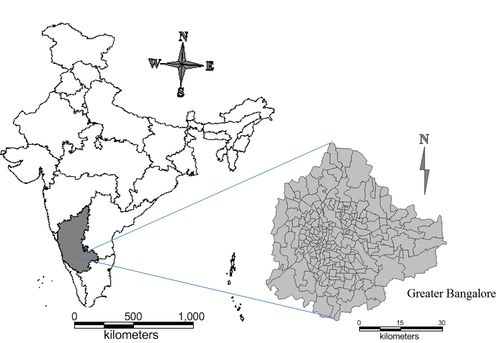
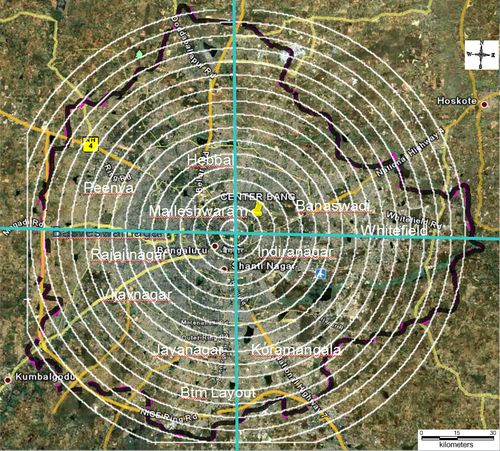
 (1)
(1)







